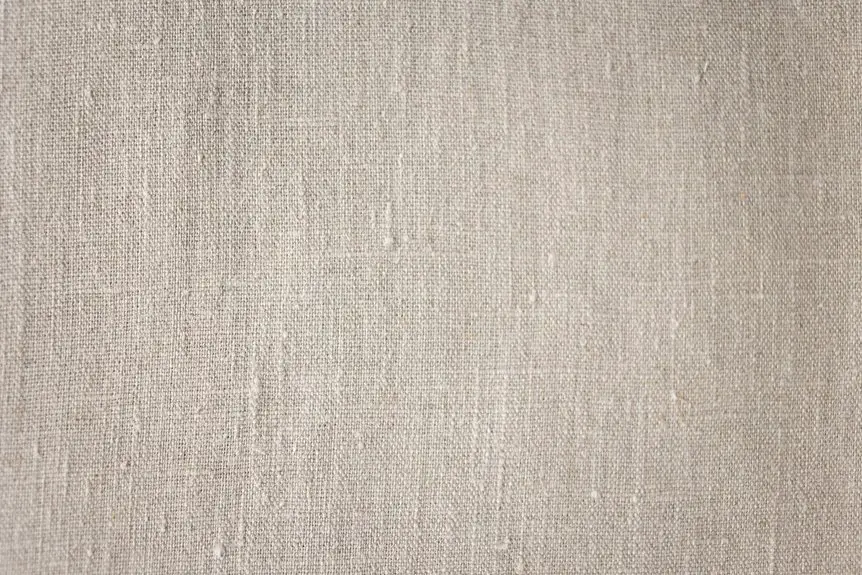Did you know linen fibers can absorb up to 20% of their weight in moisture without feeling damp, while cotton holds onto moisture longer? If you’re trying to stay cool and comfortable when temperatures soar, the way a fabric handles sweat makes a big difference. Understanding how linen and cotton manage moisture can help you choose the right material for hot weather—and the answer might be less obvious than you think.
Table of Contents
Key Takeaways
- Linen’s hollow fibers and loose weave enable superior moisture wicking and faster drying than cotton in hot weather.
- Cotton absorbs moisture well but retains it longer, often causing a damp, uncomfortable feeling in heat.
- Linen’s breathability promotes airflow, reducing moisture buildup and enhancing comfort in humid conditions.
- Cotton’s solid fibers hold moisture, which can hinder thermal regulation compared to linen’s quick moisture release.
- Linen’s rapid moisture evaporation helps keep skin dry and cool, making it preferable for hot, humid climates.
Understanding Moisture Absorption in Linen and Cotton
Moisture absorption plays a key role in how linen and cotton perform in hot weather. When you wear these fabrics, you want them to handle sweat effectively without feeling heavy or sticky.
Linen naturally excels at moisture retention but doesn’t trap it against your skin, thanks to its loose weave and hollow fibers. This design boosts fabric breathability, allowing air to circulate freely and keeping you cool.
Cotton also absorbs moisture well but tends to hold onto it longer, which can make you feel damp. Understanding these differences helps you choose the right fabric to stay comfortable.
Cotton absorbs moisture effectively but retains it longer, which might leave a damp feeling during wear.
When you pick linen, you benefit from quick moisture management paired with excellent airflow, while cotton offers softness with slightly slower moisture release.
Comparing Wicking Properties and Drying Speeds
Although both linen and cotton can absorb sweat, they differ considerably in how they wick moisture away from your skin and how quickly they dry.
When choosing between them for hot weather, consider these key points:
- Linen excels in fabric breathability, allowing moisture to evaporate faster, reducing moisture retention on your skin.
- Cotton, while soft, tends to hold onto moisture longer, which can make you feel damp during intense heat.
- Linen’s fibers create micro-channels that actively pull sweat away, enhancing wicking properties and speeding up drying times.
If you want clothing that keeps you dry and comfortable, linen’s superior wicking and rapid drying give it the edge over cotton in managing moisture effectively during hot weather.
Impact of Fiber Structure on Moisture Management
Understanding how linen and cotton handle sweat starts with looking closely at their fiber structures.
Sweat management in linen and cotton begins with understanding their distinct fiber structures.
Linen fibers are hollow and have a rough surface, which promotes excellent air circulation and quick moisture evaporation. This unique fiber characteristic reduces moisture retention, keeping you feeling cooler and drier.
Cotton fibers, on the other hand, are solid and smooth, allowing them to absorb more moisture but also retain it longer. While cotton’s higher moisture retention means it soaks up sweat effectively, it can leave you feeling damp in hot weather.
When you choose between linen and cotton, consider how these fiber characteristics impact moisture management—linen’s structure helps moisture escape faster, while cotton holds onto it, affecting how comfortable you stay in the heat.
Comfort Levels in Hot and Humid Conditions
When you face hot and humid conditions, how comfortable your clothing feels can make a big difference in your day.
Comfort hinges largely on breathability factors and effective thermal regulation. Both linen and cotton offer unique advantages, but understanding their differences helps you choose better.
- Linen’s loosely woven fibers enhance airflow, improving breathability factors and keeping you cooler.
- Cotton absorbs moisture well but can retain it longer, sometimes reducing thermal regulation efficiency.
- Linen dries faster, minimizing moisture buildup and discomfort caused by humidity.
Choosing the Best Fabric for Sustainable Hot Weather Wear
Since you want to stay cool while reducing your environmental impact, choosing the right fabric for hot weather wear is essential. Both linen and cotton offer sustainable sourcing and eco friendly options, but their environmental footprints differ. Linen is made from flax, which requires less water and pesticides than cotton. Cotton, while breathable, often involves intensive water use unless organically grown. When selecting fabrics, look for certifications ensuring sustainable practices.
| Fabric | Water Usage | Pesticide Use | Biodegradability | Durability |
|---|---|---|---|---|
| Linen | Low | Minimal | High | High |
| Cotton | High | Variable | High | Moderate |
Choosing eco friendly options like organic cotton or linen helps you stay comfortable and support sustainable sourcing.
Frequently Asked Questions
How Do Linen and Cotton Fabrics Differ in Care and Maintenance?
You’ll want to use gentle washing techniques for both fabrics to preserve fabric longevity. Linen can handle higher temperatures but wrinkles easily, while cotton needs milder cycles to avoid shrinking. Always air dry to extend durability.
Can Linen or Cotton Blend Fabrics Improve Moisture Management?
You’ll find that linen-cotton blends enhance moisture absorption and fabric breathability, combining the strengths of both fibers. This blend keeps you cooler and drier by efficiently wicking sweat away while allowing air to circulate freely.
What Are the Price Differences Between Linen and Cotton Clothing?
Did you know linen garments can cost up to 30% more than cotton? When you compare price, cotton usually wins for fabric affordability, making it a budget-friendly choice while linen offers a premium feel and durability.
How Do Linen and Cotton Fabrics Perform in Cold or Dry Climates?
You’ll find linen less effective in cold weather performance since it’s breathable but not insulating. Cotton offers better dry climate comfort by retaining warmth and moisture, making it more suitable for chilly, arid conditions you might face.
Are There Specific Brands Known for High-Quality Linen or Cotton?
Imagine luxury brands crafting linen that feels like a cool breeze, while sustainable options offer cotton as soft as a cloud. You’ll find both high-quality choices that blend elegance with eco-friendly comfort for your wardrobe.
- The Use of Nonwovens in Construction and Civil Engineering - July 11, 2025
- The Use of Nonwovens in Construction and Civil Engineering - July 11, 2025
- The Use of Nonwovens in Construction and Civil Engineering - July 11, 2025







